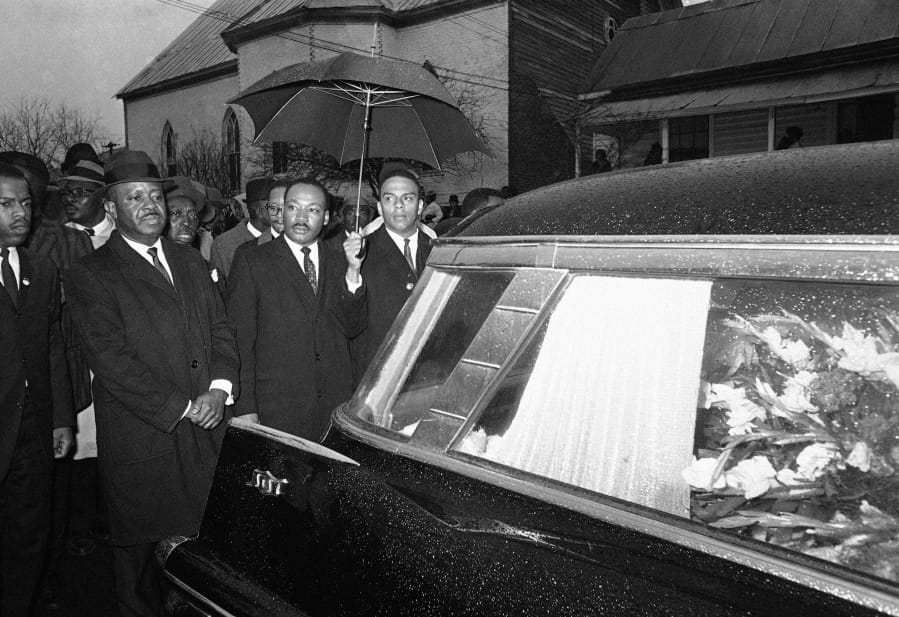MARION, Ala. — Della Simpson Maynor remembers the mounted police officer cracking her elbow with a baton. She recalls the panicked marchers unable to escape the onslaught, and the scuffle between officers and a young church deacon who was trying to protect his mother and grandfather. Most of all, she remembers the gunshot.
Two weeks before Bloody Sunday — the clash in Selma on March 7, 1965, that helped propel passage of the Voting Rights Act of 1965 — there was a march in this small town 30 miles away.
What happened in Marion is now a less-familiar episode in the civil rights movement, a footnote in the textbooks. But the blood spilled here would send hundreds of people from Marion and the surrounding county to Selma and the Edmund Pettus Bridge, where history was made.
“Starting the story in Selma is like reading a book by starting in the middle and not going back to the beginning so you can get the total picture of what actually happened in 1965,” said Perry County Commissioner Alfred Turner Jr. “Without the events occurring in Marion, there’s no way you would have gotten the same results or the optics of Bloody Sunday.”
The protest in Marion was sparked by the arrest of a minister who was leading efforts to register black people to vote. It ended with the fatal shooting of a 26-year-old black church deacon, Jimmie Lee Jackson, by a state trooper.
As the 55th anniversary of Bloody Sunday approaches, people here say they want the full story remembered.
The Rev. James Orange of the SCLC organized protests in Marion and Perry County, and hundreds of people were regularly arrested and jailed. When students began skipping school to join the marches, authorities arrested Orange on Feb. 18, 1965, for contributing to the delinquency of minors.
Former Perry County Circuit Clerk Mary Moore, a second-grader at the time, said the arrest was hypocritical on the part of the white authorities, noting that black students back then often missed school because farmers needed them to pick cotton.
Rumors circulated that Orange would be lynched behind bars. That was by no means a far-fetched fear.
“Black folks in jail ended up dead. That’s the way it was then,” said 83-year-old Elijah Rollins, then owner of one the town’s funeral homes. “It was just tradition.”
Townspeople planned a night protest march from Zion Methodist Church to the jail on the next block. State and local police were waiting for them outside, where the streetlight was either shot out or turned off. With darkness came chaos.
Rollins had skipped the church meeting but heard the commotion, and when he went outside, “a lot of people were getting the hell beat out of them.”
Maynor, then 14, watched as a pastor started off the protest by kneeling to pray, as was customary. Police officers told him to get up and clubbed him when he didn’t, she said.
“They didn’t know what your age was. They didn’t care. They swung at everybody,” she said.
Somewhere in the melee, Cager Lee, 82, and his daughter Viola Jackson were attacked by police. Lee’s grandson, Jimmie Lee Jackson, came to help them and grappled with officers inside a local hangout, Macks Cafe.
“A few minutes later you heard the gunshot,” Maynor said.
Jackson had a stomach wound and was taken to the black hospital in Selma, where he died eight days later. Rollins, who heard him screaming in pain two days before, picked up the body.
SCLC and local leaders began talking almost immediately about taking his body from Marion to Alabama’s capital, Montgomery, but that idea was abandoned. They decided to lay Jackson to rest at a Marion-area cemetery at a funeral attended by King himself, and later march to the capital from Selma, a more logical staging point.
“We will take this problem to Montgomery and leave it on Wallace’s doorstep,” King told Young, referring to Alabama’s arch-segregationist governor, George Wallace.
Plans were made for the 54-mile march from Selma to Montgomery, but on the day chosen, King was back home in Atlanta, and the federal observers who normally shadowed him and presumably would have served as a deterrent against violence weren’t there when hundreds of marchers with backpacks gathered at the bridge.
State troopers and local police were waiting for them and attacked with clubs and tear gas.
The TV footage and other images from that day shocked the country and helped lead to the landmark federal law protecting the right of African Americans to vote.
Fowler pleaded guilty in 2010 to manslaughter and served five months in jail. The mayor, police chief, sheriff and numerous other public officials in Marion and Perry County also are African American.
In a letter to the Department of Interior supporting Marion’s inclusion, Rep. Terri Sewell of Alabama cited the role Jackson’s death played in the Selma march, saying that nearly 300 of the more than 500 people who participated on Bloody Sunday were from Marion.
“They paved the way and gave the push to change the world,” said Marion Mayor Dexter Hinton.



